- Home
- slideshows
- miscellaneous
- 7 maps and charts show the state of abortion access in America
7 maps and charts show the state of abortion access in America
Abortion clinics per state, 2014

Percentage of counties without a known clinic, 2014
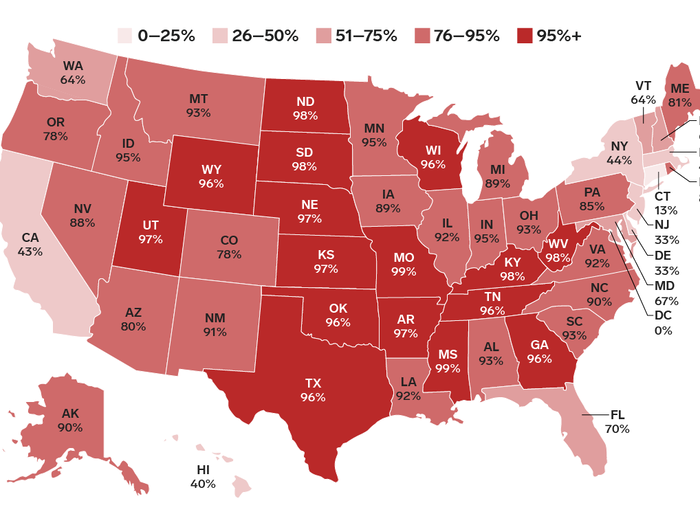
The Supreme Court struck down one of the most extreme TRAP laws, Texas' HB2, in a 5-3 vote in 2016. But despite that, over 20 states still have such laws on their books.
A closer look at the county level shows stark disparities in abortion access across the country. There are now 16 states where 95% of counties do not have an abortion clinic.
Sources: Business Insider, National Center for Biotechnology Information
Percentage of women aged 15–44 living in a county without a clinic, 2014
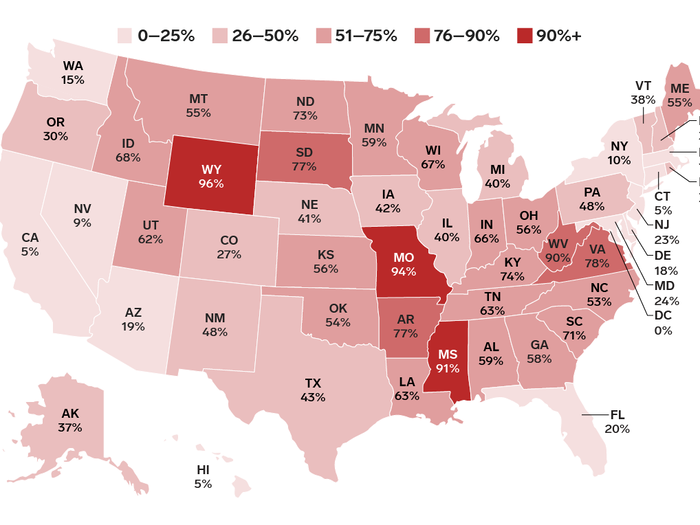
By causing clinics to close down, TRAP laws have the consequence of making patients further and further to get to a clinic, especially in states that require patients to make multiple trips to the clinic and undergo a 24-to-72 hour "waiting periods."
According to a 2017 study from the Guttmacher Institute, one in 5 American women have to travel at least 43 miles to reach their closest abortion provider. Between 2011 and 2014, the distance required to reach a clinic increased in seven states.
Researchers found notable increases in distance to a clinic in Missouri and Texas, states that had introduced TRAP laws.
"Increased travel distance means increased costs for transport, overnight stay, lost wages from time off work, and childcare," wrote Dr. Ushma Upadhyay, a professor of obstetrics and gynecology at the University of California.
She continued: "For a woman who is economically disadvantaged, having to travel a long distance could put an abortion out of reach, leading her to carry an unwanted pregnancy to term."
Sources: National Center for Biotechnology Information, Guttmacher Institute, The Lancet Public Health
How the phases of pregnancy and fetal development line up with abortion ban laws
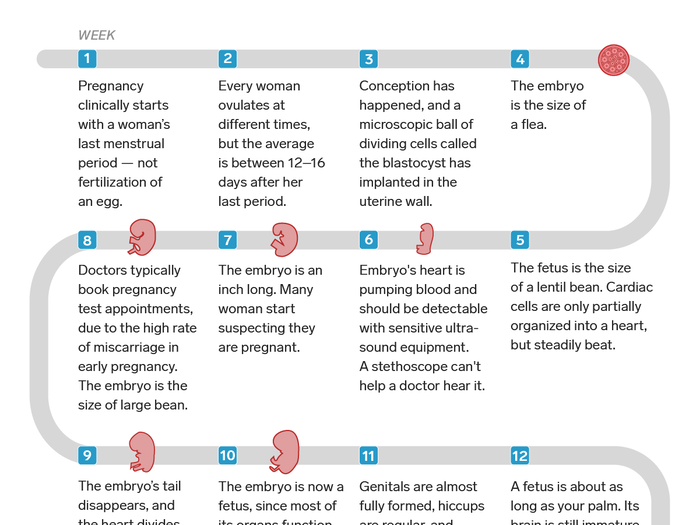
In the past several years, states have made many attempts to restrict patients from getting abortions after a certain number of weeks — oftentimes before a woman even knows she's pregnant.
In December 2016, the Ohio state legislature passed a "heartbeat bill" that would have banned abortions after six weeks, or when a fetal heartbeat can be detected, even though many women don't know they're pregnant until after that point. Gov. John Kasich vetoed the bill and signed a 20-week ban into law on the same day.
Other states have tried to ban dilation & evacuation (D&E), the method commonly used to perform abortions after 14 weeks. The surgical procedure is usually used in late-term miscarriages and abortions to remove the fetal tissue as safely as possible. They account for less than 0.5% of all abortions.
Prohibiting D&E abortions is effectively a ban on all second-trimester abortions, landing such bans in murky legal territory.
In Roe v. Wade, the Supreme Court didn't specify when abortions were legal, deciding at the time to vaguely make it unconstitutional to outlaw them up until the fetus was "viable," since the science hadn't (and still hasn't) determined at the time when that was, medically speaking.
Texas and Alabama's D&E bans have reached federal appeals courts, and the Supreme Court could hear them in the upcoming term.
Percent of adults in 2017 who say abortion should be
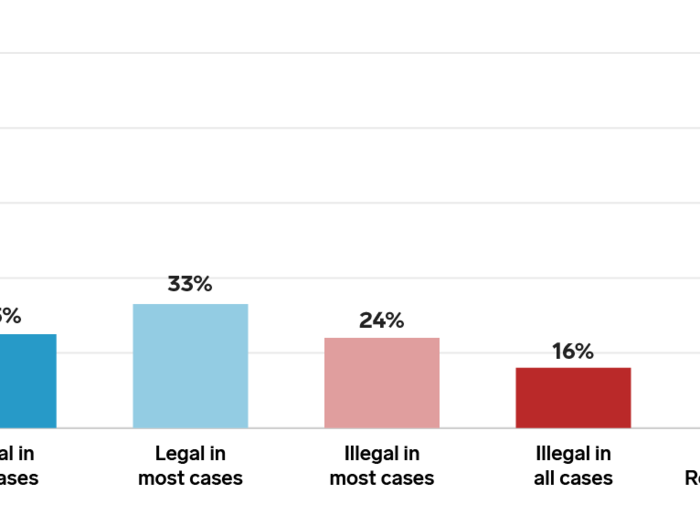
While the last decade has seen an explosion in abortion restrictions, Americans as a whole haven't become more anti-abortion in the past 20 years.
Currently, 58% of adults say abortion should be legal in all or most cases, while 40% say it should be illegal in all or most cases. Those numbers are almost exactly the same as they were back in 1995.
Source: The Pew Research Center
Political party and ideology who think abortion should be
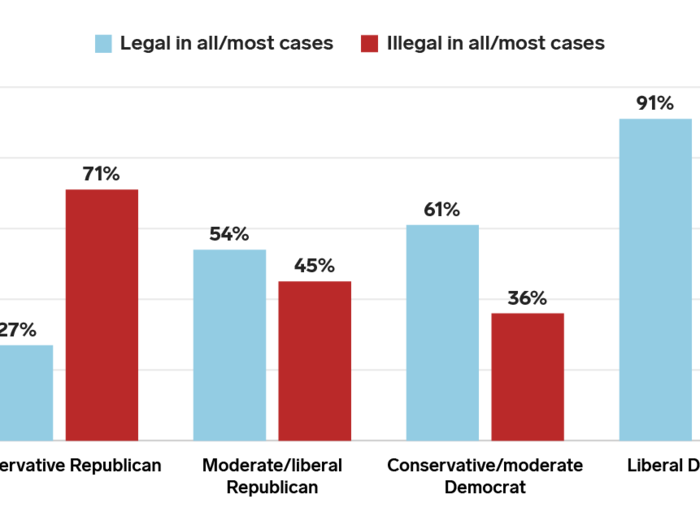
Support for abortion has long been a partisan issue, with support for abortion in all or most cases being highest among liberal Democrats and lowest among conservative Republicans.
But over a quarter of those who identify as conservative Republicans now believe abortion should be legal in all or most cases.
Despite the partisan divides, bipartisan support for Roe v. Wade is at a new high. A Wall Street Journal/NBC News poll released July 23 found that 71% of Americans and 52% of Republicans polled believed that Roe v. Wade should not be overturned.
Source: Pew Research Center, NBC News
What would happen state-by-state if Roe v. Wade fell

If the Supreme Court does overturn Roe, the issue of abortion will go back to the states. Elizabeth Nash, a senior state issues manager at the Guttmacher Institute, explained all the possible outcomes to Business Insider.
Four states passed "trigger laws" after Roe was decided, which would automatically make abortion illegal as soon as the decision is overturned.
But 10 states have pre-Roe abortion bans or restrictions still on their books that are currently un-enforceable because they violate Roe. Unlike trigger laws, Nash explained, these bans wouldn't go back into effect immediately. A government actor like an attorney general or a legislature would have to put them back in place.
Seven states have passed decrees that are "without the force of law" expressing their intent to limit abortion to the greatest extent permitted by federal law if Roe falls, Nash said.
On the flipside, nine states have laws on the books that ensure abortion stays legal within their borders.
Sources: Guttmacher Institute, Business Insider
Popular Right Now
Advertisement